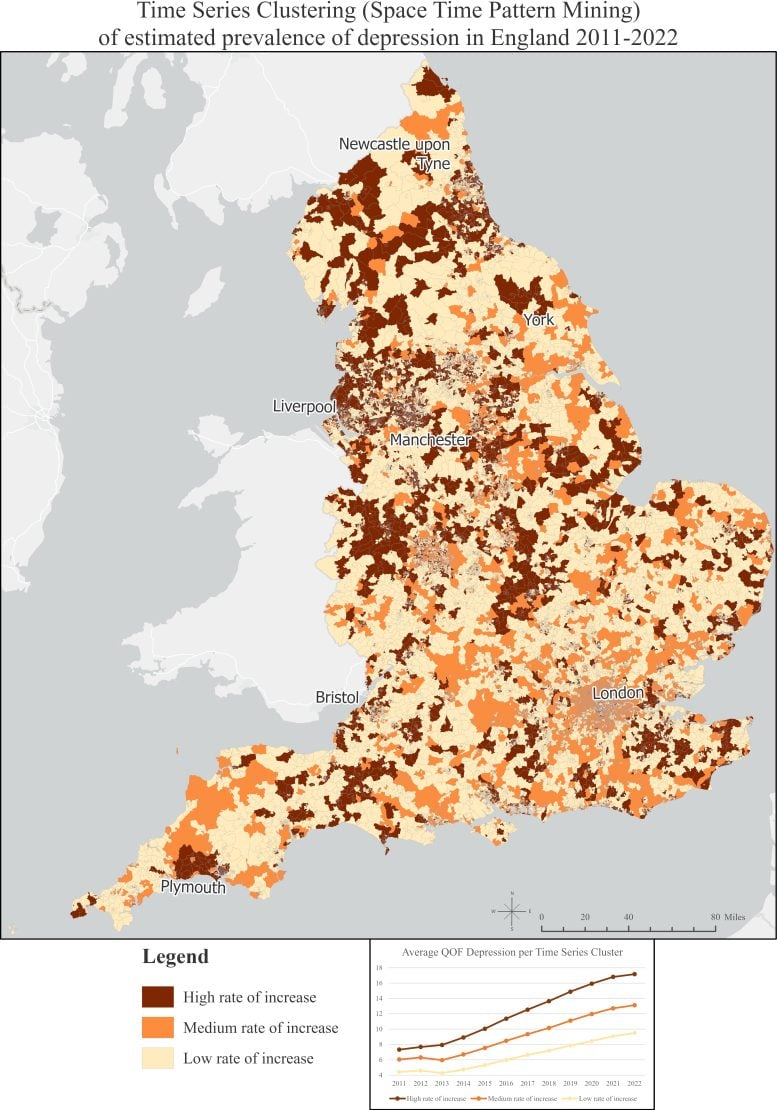Do You Live in One?


Research from the University of Southampton highlights increasing mental health inequalities in England, with significant regional disparities in the correlation between socioeconomic conditions and depression. The study underscores the necessity for tailored public mental health interventions.
A study conducted by the University of Southampton indicates that certain areas of England have experienced growing mental health disparities for over ten years, although the extent of these inequalities varies significantly across the country.
The study, in collaboration with the University of Liverpool, examines the relationship between socioeconomic conditions within local areas and the mental health of people who live there.
The researchers analyzed data covering a 12-year period and mapped ‘hot spots’ across the country where people have been coping with a very low standard of living and where there have been, and continue to be, high levels of depression in the community.
They found deprivation accounted for up to 39 percent of the recorded levels of depression across all the regions of England. However, the link between the two is highly variable across the nation, with pockets of the country where the association is very strong and other areas where it is not.
This suggests that different interventions are needed in different areas to tackle depression.
The Importance of Spatial Context
Dr Dalia Tsimpida, Lecturer in Gerontology at the University of Southampton and honorary Lecturer in Public Health at the University of Liverpool, explains: “Understanding where and why depression rates are increasing is key to tackling widening mental health inequalities. Our study provides the first comprehensive nationwide picture of these patterns, offering valuable insights for targeted public mental health interventions.
“Our research underscores the importance of spatial context in understanding mental health outcomes. Populations with similar characteristics living in close proximity often share common experiences and mental health challenges, leading to varying levels of ‘spatial mental burden’ across different areas.”
The findings were published in the journal SSM Population Health.

Study Findings and Geographical Analysis
The researchers examined rates and geographical distribution of depression using an NHS database which records the annual percentage of adults diagnosed with the condition across some 32 thousand small census areas of England. By combining this with a corresponding index showing rates of deprivation, they were able to be the first to analyze in detail the spatial relationship between the two. The research covers a period between 2011 and 2022.
The study revealed that during these 12 years, the North West and North East of England experienced very significant ‘hot spots’ of both depression and deprivation. In the North West, these clusters accounted for around 17 percent of the geographical area of the region and in the North East, 10 percent.
The North West had the largest percentage in England of areas with a high rate of increase in depression prevalence, at 43 percent. This indicates that mental health inequalities are widening rapidly here. In the North East, mental health inequalities are also widening at a higher rate compared to other regions in the country. Here, one in three people reside in areas marked by persistently high depression rates, which stands as the highest proportion among all regions nationwide.
Contrasting Trends in London and the South East
By contrast, London had the lowest percentage of hotspots for depression and deprivation, with only 0.38 percent of its overall area falling into this category. The city also had a very low percentage (0.005 percent) of its population living in these areas.
These low levels are echoed across much of the southeast of England, leading the researchers to suggest there is a North / South divide in mental health outcomes, with areas around Newcastle, Preston, Liverpool, Manchester, and Leicester all showing high levels of both depression and deprivation. Towns and cities in the South show much lower rates, although hotspots still occur in areas of the South West, near Bristol, Plymouth, the Dorset coast, and the east of Kent.
Dr. Tsimpida comments: “The relationship between socioeconomic deprivation and depression is complex and varies across different regions, suggesting that traditional randomized controlled trials (RCTs) may not fully capture these spatial influences. To better understand depression, future mental health research should consider contextual factors beyond individual characteristics.”
The study authors say their results show a need for region-specific strategies to effectively target areas with the highest need, particularly in the North West and North East. By identifying hotspots, policymakers can allocate resources more effectively, focusing on prevention and intervention strategies that address the root causes of mental health inequalities.
Co-author, Rhiannon Corcoran, Professor of Psychology and Public Mental Health at the University of Liverpool, adds: “Our study suggests that treating depression may involve addressing not only individual issues but also the characteristics of the neighborhood in which a person lives. This new level of understanding, focusing on geographical context, can guide evidence-based public mental health interventions. By identifying and monitoring high-priority areas with the greatest need, resources can be more effectively allocated for targeted support.”
Reference: “Unravelling the dynamics of mental health inequalities in England: A 12-year nationwide longitudinal spatial analysis of recorded depression prevalence” by Dialechti Tsimpida, Anastasia Tsakiridi, Konstantinos Daras, Rhiannon Corcoran and Mark Gabbay, 15 April 2024, SSM – Population Health.
DOI: 10.1016/j.ssmph.2024.101669
Source link



